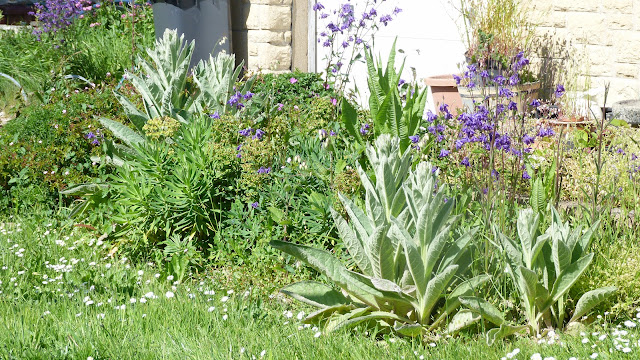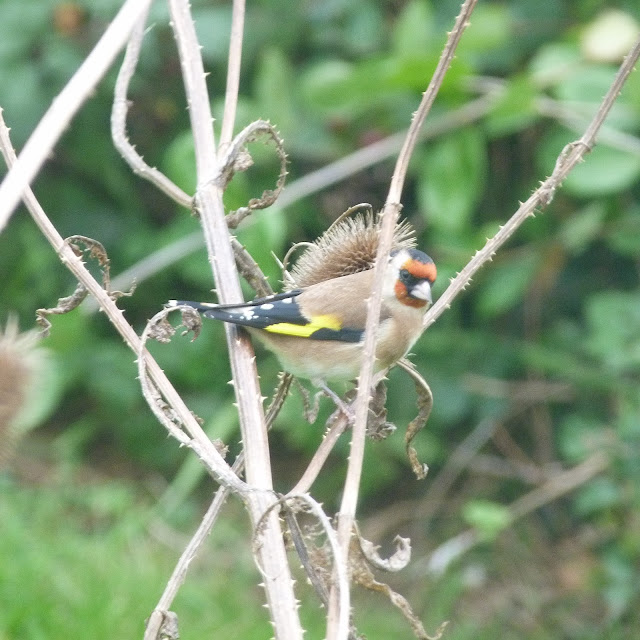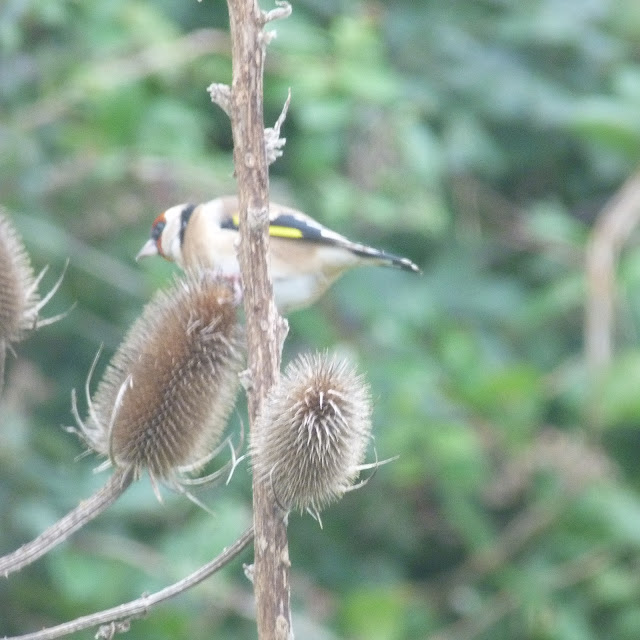Hello Friends!
Thank you everyone for your kind wishes yesterday, and lovely comments for my birthday. Also, thank you to those who sent cards and phoned me. And if you sent chocolate even better, it was most appreciated!
I guess I'm playing with words from the film Field of Dreams. If you build it, they will come. Well, if you plant it, hopefully they will come. What are they? Why goldfinches, of course! I planted, and come they did!
Teasles are a favourite food of goldfinches. And if you have teasels in your garden, you will pretty much be guaranteed to see goldfinches feeding, especially during autumn and winter.
Back in the spring, one day my phone rang, and it was my friend Briget. Did I want some teasel plants? Did I ever? Yes please!!! I'd no sooner hung up the phone and she was knocking on my door with beautiful teasel plants. She was kind enough to even dig them in for me because I couldn't dig the holes.
Here they are after a few weeks, the elongated pointy leaf plants on the left.
Over the summer months, I had to water them to get them settled in but they established quickly and they grew well. The only problem was with the sturdy winds that blew throughout the summer they tended.to keep lying down and having a rest. I suppose I should have staked them. I will know for next year.
The Mulleins also did well, they attract the Mullein moth and are one of my favourite garden plants. I let this border grow wild, unweeded.
Unfortunately, beautiful though it be, the Mullein moth caterpillar has a voracious appetite and pretty soon the stalks of the Mullein are stripped bare, almost overnight! They don't look very pretty, but I tolerate this leaflessness in order to encourage a healthy army of caterpillars. The caterpillars get big! I do my bit to help them along.
Despite the caterpillars stripping the stalks of the plant bare, they still managed to flower, so seeds will set plants for future years. The cycle will repeat and Mullein moths will hopefully thrive!
Let's return to the goldfinches. The teasles grew and flowered and seedheads formed.
They make me think of headbanded women working out to Flashdance in the early '80's when aerobic classes were a thing.
Then one joyful day, I looked out into the garden, and this is the sight that I saw. Beautiful goldfinches feeding on the seed heads
Here's a couple of some feeding on some other seed heads that got left behind in the border.
While I'm fine with people feeding the birds, I look upon bird feeders as a supplementary food source. Birds need to continue foraging, which is their natural way of finding food. If they become too dependent on bird feeders, they lose the ability to forage then when we stop putting the feeders out, they can starve. This is why it is vital for us not to keep our garden borders too well manicured and try to grow native wildflowers. for natural bird feed.
One of my lovely birthday gifts yesterday was this thoughtful mini art prints and holder set from Mary's House Designs
Which came with a packet of wildflower seeds that I will scatter next year.
The wildflower design my friend chose was Daisies and Forget Me Nots, the latter being the symbol of the Alzheimer's society, a cause very near and dear to my heart.
copied from Mary's online shop
Included in this set is a 5g packet of wildflower seeds; these seeds are specifically chosen to attract bees, butterflies and other insects. The BSBP 100% Bees & Butterfly Wildflower Seed mix is designed to provide maximum pollen and nectar and creates a beautiful meadow and wildlife habitat.
Contains 24 species from the RHS "Perfect For Pollinators" list.
Also includes borage and sainfoin to encourage a wide range of pollinating insects.
Inclusion of annuals species provides colour in the first year, plus yellow rattle.
Perfect for creating a long lasting meadow and wildlife habitat.
So I planted teasles and they came. Now, every afternoon, around 3:15. in they swoop, my little Charm of Goldfinches. Next year, thanks to my gift, the variety of plants and birds will be even greater.
Until next time
Stay safe. Stay well.
Debbie xx
p.s. Editing to add that teasels are so called because in the dried heads of the plant were once used in the textile industry to raise the nap on woolen cloth, or to tease the nap.
.jpg)



.jpg)

.jpg)
.jpg)







.jpg)
.jpg)
.jpg)


Lovely goldfinch photos and a pretty gift.
ReplyDeleteI used to cut teasels, spray them gold and sell at the gate near Christmas - now I feel guilty!
Thank you. I'm sure we've all been guilty of that at some point in our past. Just to let you know I've made a small edit, but you probably already know that the dried heads of the plant were once used in the textile industry to raise the nap on woolen cloth.
DeleteI love the hooder for those art prints! Lovely gift. And your garden is looking good. Don't you love how gardens change in the fall? I think it might not rain today and if it doesn't I'll be out cutting back sweet peas.
ReplyDeleteThank you. Yes. it's almost impossible to get a garden looking good in every season, isn't it Some will look better than others, But you can guarantee there's always work to do!
DeleteI garden for nature and since we have been here and no chemicals have been on the land and other areas allowed to grow long until the autumn we have had a wonderful array of different wildlife. Need more Teasels though! Delighted to see a baby slowworm this year - having seen an adult last year.
ReplyDeleteThank you. 0h what a treat it would be to have a slow worm in the garden!
DeleteP.S. I just love your wild border and natural plantings.
ReplyDeleteMost of it is not of my choosing It's done it itself. Best kind of gardening really
DeleteGlad you had a good birthday and such lovely gifts. So pleased you had Goldfinches on your teasels :) It goes to show how planting with wildlife in mind works :) I planted a teasel at the caravan but sadly it never flowered this year but we leave seedheads over winter in the herbaceous border at home and get goldfinches there - they particularly like lavender seedheads! and I get them on the feeders. They are such beautiful birds.
ReplyDeleteThank you Caroline. OK, Let's not talk about my lavender heads. Somebody came in to help me tidy up the garden, and they dead headed all my lavender before I knew what they were doing. I could have cried
DeleteIt's a good job your teasels are in a wild area as they are prolific self seeders. Goldfinches are lovely birds. Unfortunately in Victorian times gthis worked against them as they were kept in cages.
ReplyDeleteThank you. The Victorians do have rather a lot to answer for, don't they? I call goldfinches dolphins of the hedgerows because of how they swoop and dive along the edges of the road.
DeleteYour garden is lovely, Deb! The teasels are the perfect seed heads for your beautiful goldfinches. I believe I have mentioned to you before that our goldfinches are all yellow compared to your lovely bird. It's so nice that they visit you around the same time each day. Our goldfinches visit our rudbeckia seed heads. I leave them just for them to enjoy. Interesting information on teasels and the textile industry!
ReplyDeleteThank you Martha Ellen Yes. because they come in at the same time most afternoons it makes it easier to watch them and photograph them Which reminds me, I must wash the windows. Lol.
DeleteI did enjoy seeing the goldfinches, lovely photographs you've shared.
ReplyDeleteHoping you have not / were not affected by Storm Babet, we did have a lot of rain but some areas had it much worse.
Take care, sending my good wishes.
All the best Jan
Thank you, we had some very windy weather with sudden downpours on day one, but thankfully avoided the worse of it. Poor things in Scotland have really taken a pasting. Most of the UK felt some effect from Babet.
DeleteBeautiful Photos, Deb. As Martha Ellen said, our Goldfinches are all bright yellow, for the males and mustardy yellow for the females. Were those male birds in your photos? They certainly are striking. Love the colors on them. I had a patch of teasel that got mowed down from the company cleaning out under power lines. I could have cried, but I am hoping they will come back. I did not know the history of teasel, very interesting.
ReplyDelete